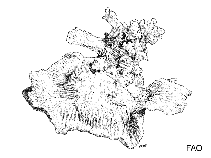Paragoniastrea australensis (Milne-Edwards & Haime, 1857)
Lesser star coral
Upload your photos
Google image | No image available for this species;
drawing shows typical species in Merulinidae.
Google image | No image available for this species;
drawing shows typical species in Merulinidae.
Classification / Names Common names | Synonyms | CoL | ITIS | WoRMS
Anthozoa | Scleractinia | Merulinidae
Environment: milieu / climate zone / depth range / distribution range Ecology
Reef-associated; depth range 0 - 40 m (Ref. 848). Tropical; 36°N - 37°S, 32°E - 108°W (Ref. 848)
Distribution Countries | FAO areas | Ecosystems | Occurrences | Introductions
Indo-Pacific and Southwest Atlantic.
Length at first maturity / Size / Weight / Age
Maturity: Lm ? range ? - ? cm
Short description Morphology
Colony: massive, submassive, or encrusting. Corallites: very meandroid with long valleys, or sub-meandroid with short valleys of 1 to 3 centers. Most with deep, steep sided valleys and distinct corallite centers. Septa: regularly spaced, equal and even; paliform lobes present; margins with fine dentations. Large and conspicuous columella. Thecae thickness varies greatly. Skeletal structures vary between environments. Colors also variable but are mostly uniformly dull brown or green; walls and valley floors occasionally in contrasting colors (Ref. 085244).
Found on rocky and gravel bottom at depths between 1.8 to 21.6 m. Also on volcanic submarine beds (Ref. 88968) and most tropical coral reef environments (Ref. 85244).
Life cycle and mating behavior Maturity | Reproduction | Spawning | Eggs | Fecundity | Larvae
Hermaphroditic (Ref. 113712). Mature gametes are shed into the coelenteron and spawned through the mouth. Life cycle: The zygote develops into a planktonic planula larva. Metamorphosis begins with early morphogenesis of tentacles, septa and pharynx before larval settlement on the aboral end (Ref. 833).
Main reference
References | Coordinator | Collaborators
Veron, J.E.N. 2000. (Ref. 848)
IUCN Red List Status (Ref. 130435)
Least Concern (LC) ; Date assessed: 03 January 2008
CITES status (Ref. 108899)
Appendix II: International trade monitored
CMS (Ref. 116361)
Not Evaluated
Threat to humans
Human uses
| FishSource |
Tools
More information
Internet sources
BHL | BOLD Systems | CISTI | DiscoverLife | FAO(Publication : search) | Fishipedia | GenBank (genome, nucleotide) | GloBI | Gomexsi | Google Books | Google Scholar | Google | PubMed | Hexacorallians of the World | Tree of Life | Wikipedia (Go, Search) | Zoological Record
Estimates based on models
Preferred temperature
(Ref. 115969): 23.8 - 27.8, mean 26.7 (based on 162 cells).
Price category
(Ref. 80766):
Unknown.



